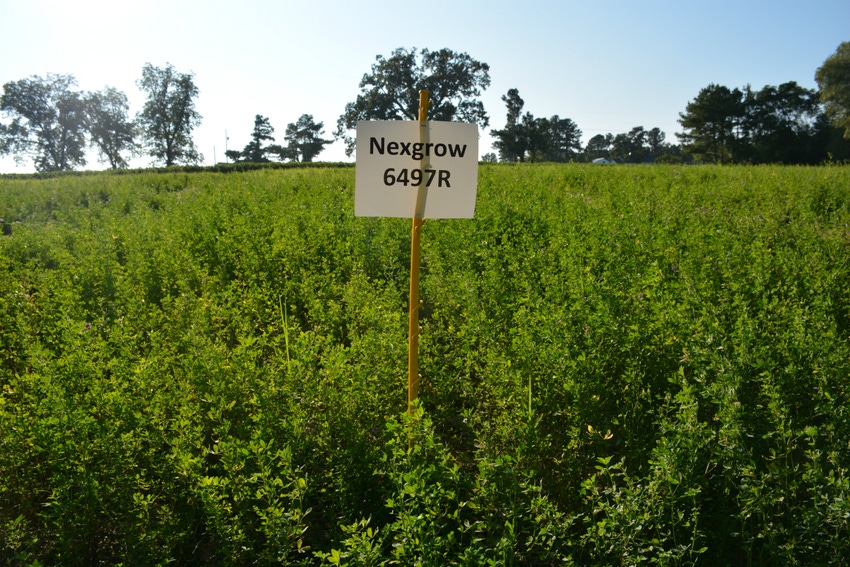
When he talks to farmers about growing alfalfa, Dennis Hancock says he will either talk them into it or talk them out of it. It’s a challenging crop to grow, but it does offer its rewards.
“Like everything in life, if you put more into it you get more out of it,” says Hancock, professor and state Extension forage specialist with the University of Georgia. “If you have a really good management aspect of alfalfa, you can produce some straight up rocket fuel.”
Hancock made a trip up to North Carolina to speak at an Extension Alfalfa-Bermudagrass-Hayfield Conference at the Harnett Commons Area in Lillington, N.C. North Carolina State University sees great potential for alfalfa in the state and is conducting research on the crop
In North Carolina, Extension agents in Johnston, Harnett, Wake and Sampson counties have planted demonstration plots to see if alfalfa can be grown inter-seeded with bermudagrass. In addition, Harnett County Extension Agent Brian Parrish notes that three farmers in the county are growing alfalfa commercially.
“Two of the growers target the (high quality) horse hay market. They sell small square bales as a valuable cash crop,” Parrish explains in a blog posting. “The third grower is baling the alfalfa as haylage to use as a protein supplement for his cattle herd during the winter.”
Alfalfa is called “the queen of forages” because of its importance as a high-quality protein crop. Alfalfa is a cool season perennial legume that fixes its own nitrogen. It is the highest nutritive value forage grown today.
Extension agents working with alfalfa in North Carolina see great potential for the crop in the Tar Heel State. They invited Hancock to the conference to discuss the success alfalfa has seen in Georgia.
In that state, several of the research farms have successfully integrated alfalfa with bermudagrass. “One of the things they have noted is they have gone up substantially in their calving percentages,” Hancock told the North Carolina conference.
Hancock says alfalfa is doing well in Georgia, particularly in the Coastal Plain, which is roughly the southern half of the state. He notes the general assumption is that the alfalfa-bermudagrass will produce for three to five years, while some crops are still producing after 10 years and the Sunbelt Ag Expo crop is still producing in its 12th year.
“It can last a good long while if it’s managed well,” Hancock says.
Yields range from four to six tons per acre dryland and five to eight tons per acre per year irrigated, depending on the fertility of the soil and management. “Good management can overcome poor soil condition challenges,” Hancock says. “Good soil overcomes a lot of the management problems we may have. Alfalfa is really going to need your best soils and your most input. You’re really going to have to dot your Is and cross your Ts with alfalfa.”
A big plus of growing alfalfa with bermudagrass is it allows you to grow your own nitrogen, Hancock says. By adding alfalfa, you essentially eliminate adding additional nitrogen to the field.
An even more important benefit is alfalfa increases the quality of the forage. “Essentially, you can grow your own supplement as well,” Hancock says. “In our university farms, we have basically eliminated, with a few exceptions, any additional supplemental grain we are providing to our beef cattle herd because we are growing our own supplement in the form of high quality alfalfa.”
In North Carolina, Dr. Miguel Castillo, assistant professor and Extension forage specialist at North Carolina State University, is working with alfalfa and says it has a good fit in forage programs. He said the most important things North Carolina farmers need to consider before planting alfalfa are soil type and soil pH.
“Alfalfa needs well drained, deep fertile soils with no shallow hard pan or high-water table,” Castillo says. “The ideal soils for growing alfalfa are sandy loam, silt loam and clay loam. Marginal soils are loamy sand and silty clay. Undesirable soils are sand and clay.”
Alfalfa requires high pH soils, ranging from 6.5 to 7. Soils with a pH lower than 6.5 aren’t well suited for alfalfa. Moreover, poorly drained soils are a major challenge for alfalfa.
When choosing alfalfa cultivars, North Carolina farmers need to consider fall dormancy, winter survival and pest resistance.
Castillo says North Carolina farmers should plant varieties in fall dormancy Groups 4, 5 and 6, either planted alone or inter-seeded with bermudagrass. He explains that fall dormancy Groups 3, 4 and 5 are more dormant, meaning they have slow growth in the spring and reduced growth in the fall. Groups 6, 7, 8 and 9 or less dormant and keep growing in the fall.
About the Author(s)
You May Also Like






